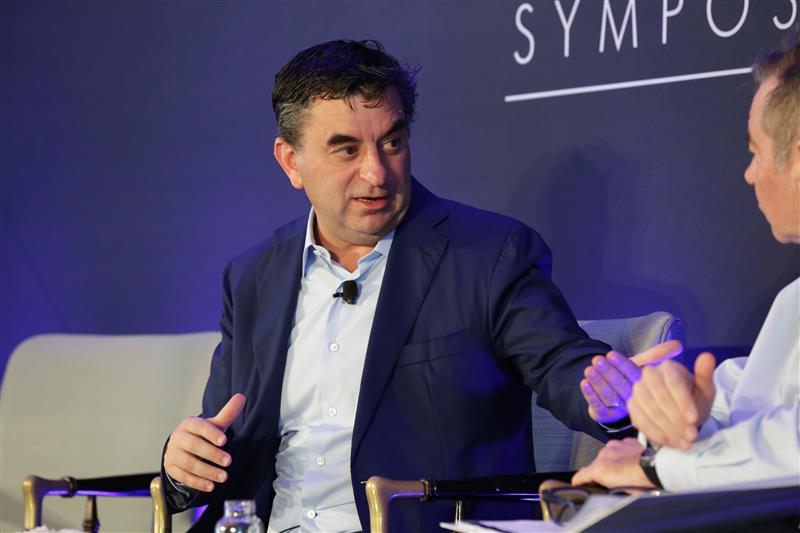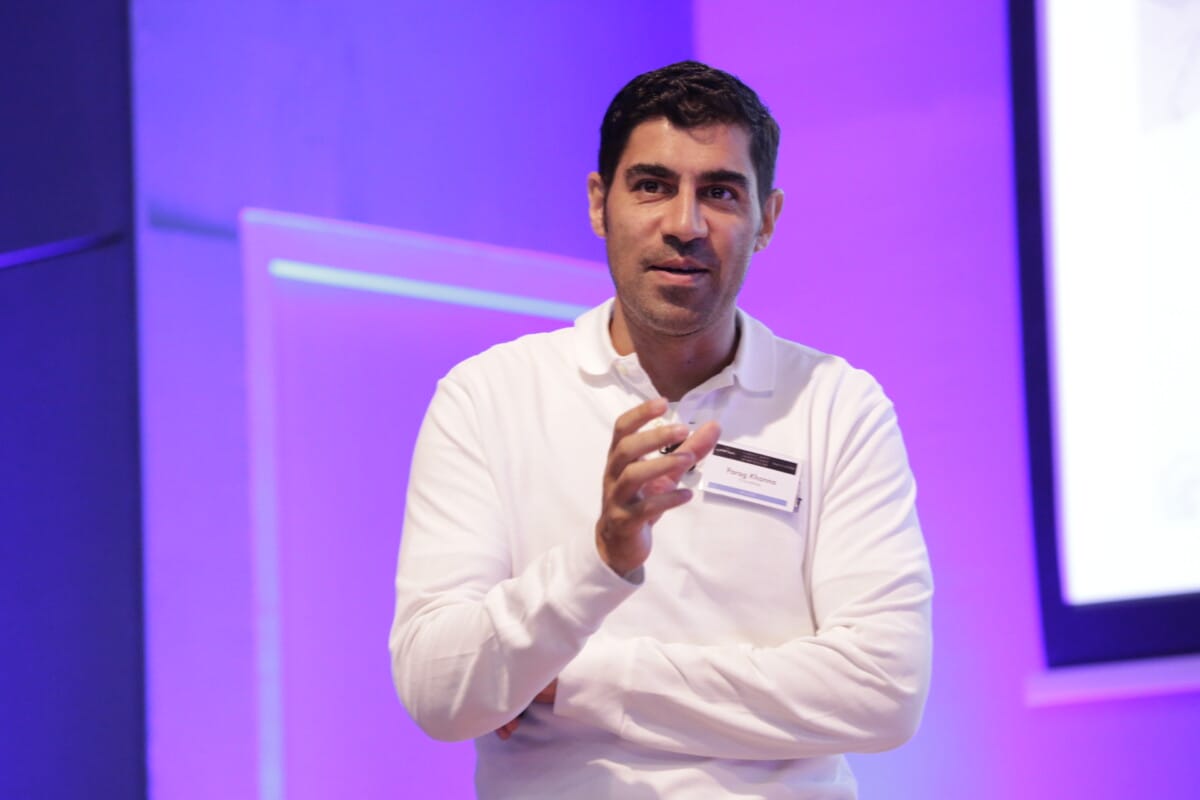Asset managers are spending vast sums of money to develop artificial intelligence systems to help them make better investment decisions. At a Top1000funds.com event in Singapore, Bridgewater co-CIO Greg Jensen discussed applying AI in financial markets as well as Bridgewater’s artificial intelligence efforts. He noted that AI could help contribute to a much needed productivity miracle.
Asset managers are spending vast sums of money to develop AI technology to support better investment decisions but applying AI to financial markets remains, according to Bridgewater’s co-chief investment officer Greg Jensen.
Jensen told the 2024 Fiduciary Investors Symposium in Singapore that AI is “great if there is a tonne of data and the future is like the past”.
“This problem is not like that,” he said. “There’s not that much data; realistically, there’s only a few cycles. You can maybe go back 150 years, and the future is not the same as the past.”
Jensen demonstrated Bridgewater’s artificial intelligence system, AIA (pronounced eye-a) to delegates at the symposium and said it had been developed to fill in the gaps in effective application of AI in financial markets.
Jensen said Bridgewater developed its own AI technology by combining the strengths of tabular data AI – which focuses on analysing classic table data sets – and large language models like ChatGPT, which offer complimentary features.
He said the strength of tabular data AI models is the ability to utilise data to understand past trends, but its flaw is an inability to offer future insights.
“This makes applying AI to financial markets quite a challenge,” Jensen said.
“If you take the best AI model… and take the best one for tabular data and you use it to predict equities, basically it can describe history incredibly well. It explains every move in the market. If you unleash it on data it’s never seen before and it doesn’t know about anything going on… it will have no idea what will happen.”
Jensen said this was despite AI being good at extracting complex dynamics and isolating impacts of individual variables in large datasets.
“They don’t know a thing about what’s happening,” Jensen said. “They’re bad at correlation versus causation. It’s important to understand them, but it’s more important in our world not to use them this way.”
Jensen said this where other forms of AI – in particular, large language models – come into play to “constrain the overfitting problem” by using data to make future predictions.
“Language models have totally different strengths to tabular data models – language AI can actually understand context and transfer human understanding from different spheres,” Jensen said.
“It can talk about markets and say something like ‘fear’ and know what fear means in a way a data series doesn’t. Of course, it’s bad in certain things. It’s bad at analytics tasks…they’re getting better, but they can also make things up. The good thing about tabular data models is they don’t make things up, they’re very precise. But language models do make things up.”
Real jeopardy
Jensen said the core of Bridgewater runs on a systematic process where computers do most of the work, but the intuition of the investment process is still all human driven.
He said the firm first started considering how AI could help humans on the intuitive part of this problem back in 2012.
It hired former IBM computer scientist David Ferruci, who led the development of the computing giant’s Watson which famously won US quiz show Jeopardy, to help design this system.
“He was sick, however, over the direction [Watson] had been taken and the things he couldn’t do – it was designed to beat Jeopardy, it wasn’t designed to do a lot of other things,” Jensen said.
“He was passionate about doing that right. He came together with me, and we’ve been thinking about how to create reasoning in artificial intelligence since then, or essentially a reasoning engine.”
Jensen was also part of the early development of OpenAI, before it pivoted to a capped for-profit company that sought to build scale. He later helped bring in the chief scientist to another AI start up, Anthropic, who would be tasked with working on the solution of dealing with small data sets in AI.
Capital space race
Jensen said the risk of capital loss in AI development would be part of the ebbs and flows of capital investing.
“If you look what it takes to have the best language model…right now OpenAI had the best model; then what Anthropic just released is pretty incredible,” Jensen said. “Staying on top of the best language model is unbelievably expensive and it has a shelf life of a couple of weeks.
“They’re going to build it. Whether that build ends up worthwhile, that’s a much, much trickier question.”
While Ferucci was recruited to help develop a system that could have a greater societal impact than winning a TV gameshow, Jensen noted a potential ceiling that still exists for AI.
“People are making the argument, which I think is a pipedream, that it will democratise intelligence – not all AI is the same, better AIs are going to win out from the worst AIs,” Jensen said.
“It’s unfortunately a winner-take-all technology because if you can do it and get the money/resources to do more of it, that is of huge benefit. How do you deal with a winner take all technology society and how do you spread that benefit? A lot of the people building this technology have the best intentions, but you don’t want to rely on that.”
Jensen believed this is where government policy should come into play to prevent the “massive economic gains” that could arise don’t end up being concentred in the hands of a few wealthy parties.
“How do you do that right now so it’s not a surprise to people when it happens? Tax the robots, tax the AI, distribute that in high quality ways and make sure the world benefits,” Jensen said.
On the impact AI will have on jobs and the general livelihoods of the working and middle classes, Jensen said society needs a workforce that is flexible enough to change as jobs fall in and out of demand.
While there’s numerous examples in history of technology replacing jobs, Jensen referred to AI being used in the US postal service to help with mail sorting.
“They started working on AI in 1998 on handwriting recognition,” Jensen said.
“Took a long time but by 2013-14, AI could recognise handwriting better than people in the post office could and nobody cared except the postal service, but the AI reads your letters. It’s not a human reading where to send the mail.”
Impact on productivity
Jensen said inflated US asset prices have created a mismatch with productivity which will require a ‘productivity miracle’ to reconcile. This is a problem AI could help to address if it can drive a modest, 1.5 per cent boost to GDP.
“If you take US asset prices, we need a productivity miracle – the only way to reconcile what is priced into asset prices is a productivity miracle,” Jensen said.
“Inflation is going to be able to fall/stay steady while earnings grow at a rate that hasn’t been priced in for a very long time. How can you get great earnings and great low inflation at a time where you’re starting with pre-used up capacity and a low unemployment rate? Basically, you need productivity.”
This is why Jensen believes even a modest 1.5 per cent boost to GDP from AI could reconcile this difference.
“That might happen, that’s probably too optimistic, long term equity prices are too high in the United States relative to what’s likely, but you at least get a sense of the line,” Jensen said.
“What I’m trying to do in my business is get an AI that learns and create that loop – it can learn, generate revenue and then learn again and get better. If you have a self-improving artificial intelligence, it of course creates a flywheel like nothing that’s ever happened before, so there is at least some chance.


